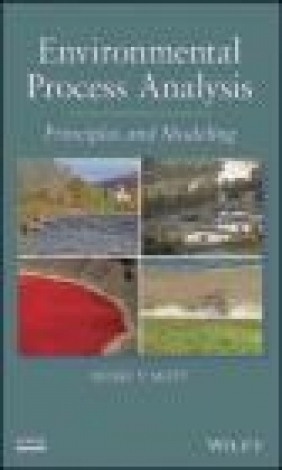Environmental Process Analysis
Henry V. Mott
Environmental Process Analysis
Henry V. Mott
- Producent: John Wiley
- Rok produkcji: 2014
- ISBN: 9781118115015
- Ilość stron: 632
- Oprawa: Twarda
Niedostępna
Opis: Environmental Process Analysis - Henry V. Mott
This book introduces students to the various contextual areas of environmental engineering and includes the application of basic mathematics, scientific principles, and beginning engineering concepts in environmental engineering. The systematic approach focuses upon context-independent applications of important chemical principles and then applies these principles to various environmental engineering topics. It also demonstrates a MathCAD worksheet for mathematically modeling various systems arising in environmental engineering. These concepts are applicable to water/wastewater treatment, surface mining, agricultural systems, landfills, aqueous and marine sediments, surface waters, and atmospheric moisture.Chapter 1 Introductory Remarks 1.1 Perspective 1.2 Organization and Objectives 1.3 Approach Chapter 2 Water 2.1 Perspective 2.2 Important Properties of Water Chapter 3 Concentration Units for Gases, Liquids and Solids . 3.1 Selected Concentration Units. 3.2 The Ideal Gas Law and Gas Phase Concentration Units. 3.3 Aqueous Concentration Units. 3.4 Applications of Volume Fraction Units. Problems Chapter 4 The Law of Mass Action and Chemical Equilibria . 4.1 Perspective 4.2 The Law of Mass Action. 4.3 Gas/Water Distributions. 4.4 Acid/Base Systems. 4.5 Metal Complexation Systems. 4.6 Water/Solid Systems (Solubility/Dissolution) 4.7 Oxidation/Reduction Half Reactions. Chapter 5 Air/Water Distribution: Henry's Law .. 5.1 Perspective 5.2 Henry's Law Constants. 5.3 Applications of Henry's Law. Problems Chapter 6 Acid/Base Component Distributions . 6.1 Perspective 6.2 Proton Abundance in Aqueous Solutions -- pH and the Ion Product of Water 6.3 Acid Dissociation Constants. 6.4 Mole Accounting Relations. 6.5 Combination of Mole Balance and Acid/Base Equilibria. 6.6 Alkalinity, Acidity and the Carbonate System. 6.7 Applications of Acid/Base Principles in Selected Environmental Contexts. Problems Chapter 7 Mass Balance, Ideal Reactors, and Mixing . 7.1 Perspective 7.2 The Mass Balance. 7.3 Residence Time Distribution (RTD) Analyses. 7.4 Exit Responses for Ideal Reactors. 7.5 Modeling of Mixing in Ideal CMFRs. Problems Chapter 8 Reactions in Ideal Reactors . 8.1 Perspective 8.2 Chemical Stoichiometry and Mass/Volume Relations. 8.3 Reactions in Ideal Reactors. 8.4 Applications of Reactions in Ideal Reactors. 8.5 Interfacial Mass Transfer in Ideal Reactors. Problems Chapter 9 Reactions in Non-ideal Reactors . 9.1 Perspective 9.2 Exit Concentration versus Time Traces. 9.3 Residence Time Distribution (RTD) Density. 9.4 Cumulative Residence Time Distributions. 9.5 Characterization of RTD Distributions. 9.6 Models for Addressing Longitudinal Dispersion in Reactors. 9.7 Modeling Reactions in CMFRs in Series (TiS) Teactors. 9.8 Modeling Reactions with the Plug-Flow with Dispersion (PFD) Model 9.9 Modeling Reactions using the Segregated Flow (SF) Model 9.10 Applications of Non-ideal Reactor Models. 9.11 Considerations for Analyses of Spatially Variant Processes. 9.12 Modeling Utilization and Growth in PFR-like Reactors using TiS and SF. Chapter 10 Acids and Bases: Advanced Principles . 10.1 Perspective 10.2 The Activity Coefficient 10.3 Temperature Dependence of Equilibrium Constants. 10.4 Non-ideal Conjugate Acid/Conjugate Base Distributions. 10.5 The Proton Balance (Proton Condition) 10.6 Analyses of Solutions Prepared by Addition of Acids, Bases and Salts to Water 10.7 Mixing of Aqueous Solutions. 10.8 Activity versus Concentration for Non-Electrolytes. Problems Chapter 11 Metal Complexation and Solubility . 11.1 Perspective 11.2 Hydration of Metal Ions. 11.3 Cumulative Formation Constants. 11.4 Formation Equilibria for Solids. 11.5 Speciation of Metals in Aqueous Solutions Containing Ligands. 11.6 Metal Hydroxide Solubility. 11.7 Solubility of Metal Carbonates. 11.8 Solubility of Other Metal-Ligand Solids. Problems Chapter 12 Oxidation and Reduction . 12.1 Perspective 12.2 Redox Half Reactions. 12.3 The Nernst Equation. 12.4 Electron availability in environmental systems. Problems Appendices References
Szczegóły: Environmental Process Analysis - Henry V. Mott
Tytuł: Environmental Process Analysis
Autor: Henry V. Mott
Producent: John Wiley
ISBN: 9781118115015
Rok produkcji: 2014
Ilość stron: 632
Oprawa: Twarda
Waga: 1.01 kg

























